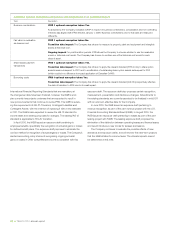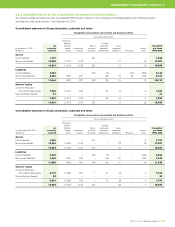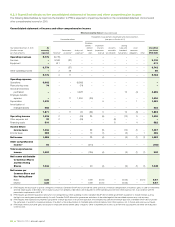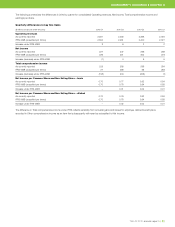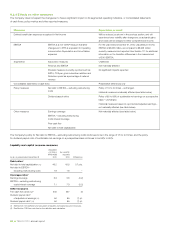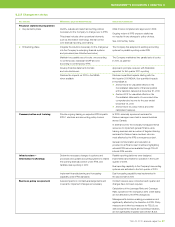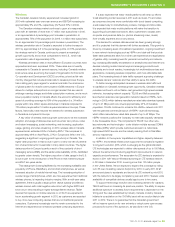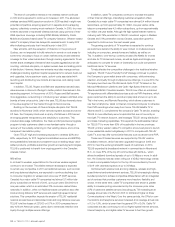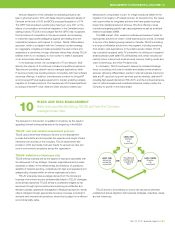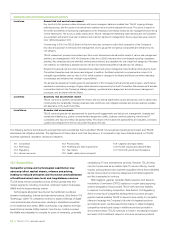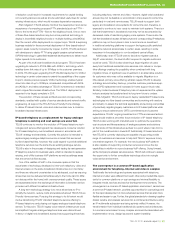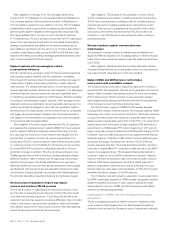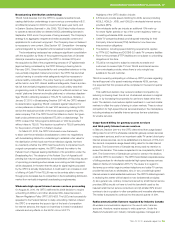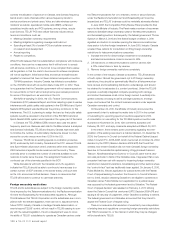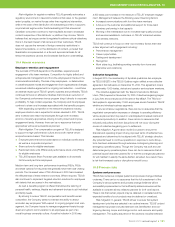Telus 2010 Annual Report Download - page 96
Download and view the complete annual report
Please find page 96 of the 2010 Telus annual report below. You can navigate through the pages in the report by either clicking on the pages listed below, or by using the keyword search tool below to find specific information within the annual report.
92 . TELUS 2010 annual report
Enterprise risk and control assessment process
Level one Annual risk and control assessment
Key inputs into this process include interviews with senior managers, data and updates from TELUS’ ongoing strategic
planning process, and the results of an annual web-enabled risk and control assessment survey. The survey is based on
the COSO (Committee of Sponsoring Organizations of the Treadway Commission) enterprise risk management and internal
control frameworks. The survey is widely distributed to TELUS’ management leadership team (all executive vice-president,
vice-president and director level team members and a random sample of management). Survey responses were received
from 1,683 individuals in 2010.
Commencing in 2010, the TELUS Board of Directors were also surveyed to solicit their perspective of the Company’s
key risks and approach to enterprise risk management, and to gauge the Company’s risk appetite and tolerance by key
risk category.
TELUS’ assessment process incorporates input from recent internal and external audits, results of various risk management
activities, and management’s SOX 404 (Sarbanes Oxley Act of 2002) internal control over financial reporting compliance
activities. Key enterprise risks are identified, defined and prioritized, and classified into one of eight risk categories. Perceived
risk resiliency (or readiness) is assessed by key risk and risk tolerance/appetite is evaluated by risk category.
Results of the annual risk and control assessment are shared with senior management and the Board (including the Audit
Committee). Executive-level risk owners are assigned. In addition, the Board undertook a comprehensive review of its
oversight responsibilities over key risks in 2010, which resulted in changes to the Board and Board committee mandates
to emphasize and enhance their oversight responsibilities.
The annual risk assessment results guide the development of the Company’s annual internal audit program, which has an
emphasis on assurance coverage of higher-rated risks and is approved by the Audit Committee. Risk assessments are also
incorporated back into the Company’s strategic planning, operational risk management and performance management
processes, and are shared with the Board.
Level two Quarterly risk assessment review
TELUS conducts a quarterly risk assessment review with key internal stakeholders across all business units to capture and
communicate the dynamically changing business risks, identify key risk mitigation activities and provide quarterly updates
and assurance to the Audit Committee.
Level three Granular risk assessments
TELUS conducts granular risk assessments for specific audit engagements and various risk management, strategic and
operational initiatives (e.g. project, environmental management, safety, business continuity planning, network and IT
vulnerability, and fraud and ethics risk assessments). The results of the multiple risk assessments are evaluated, prioritized,
updated and integrated into the key risk profile throughout the year.
The following sections summarize the principal risks and uncertainties that could affect TELUS’ future business results going forward, and TELUS’
associated risk mitigation activities. The significance of these risks is such that they alone or in combination may have material impacts on TELUS’
business operations, reputation, results and valuation.
10 .1 Competition 10.5 Process risks 10.9 Litigation and legal matters
10.2 Technology 10.6 Financing and debt requirements 10.10 Human-caused and natural threats
10.3 Regulatory 10.7 Tax matters 10 .11 Economic growth and fluctuations
10.4 Human resources 10.8 Health, safety and environment
cannibalizing TV and entertainment services. However, TELUS views
over-the-top services as a possible Optik TV service offering. Overall,
industry pricing pressure and customer acquisition efforts have intensified
across most product and service categories and market segments,
and this is expected to continue.
Risk mitigation, general: Canadian Radio-television and Telecom-
munications Commission (CRTC) decisions in recent years approving
wireline deregulation have provided TELUS with improved flexibility
to respond to intensifying competition. (See Section 10.3 Regulatory.)
Active monitoring of competitive developments in product and geo-
graphic markets enables TELUS to respond more rapidly to competitor
offers and leverage the Company’s full suite of integrated solutions
and national reach. As discussed further below, to offset increasing
competitive intensity and losses in traditional services provided in
its incumbent areas, TELUS continues to invest in increasing the speed
and reach of its broadband networks, introduce innovative products
10.1 Competition
Competitor pricing and technological substitution may
adversely affect market shares, volumes and pricing,
leading to reduced utilization and increased commoditization
of traditional wired voice local and long distance services
TELUS faces intense competition across all key business lines and
market segments, including consumers, small and medium businesses
(SMB) and the large enterprise market.
Technological advances have blurred the traditional boundaries
between broadcasting, Internet and telecommunications. (See Section 10.2
Technology.) Cable-TV companies continue to expand offerings of digital
voice and enhanced phone services, resulting in intensified competition
in the residential and certain SMB, local access, long distance and high-
speed Internet access (HSIA) markets. Over-the-top content providers
like Netflix are anticipated to compete for share of viewership, potentially


